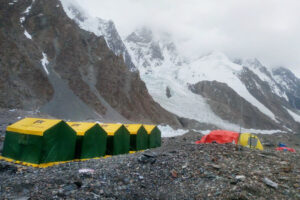By: Sebastian Alvaro Lomba
Courtesy: marca.com
Original translation: K2 Pakistan
The season that has ended in the Karakorum has been relevant because there have been almost 70 ascents of K2, a record since this mountain was first climbed by an Italian expedition in 1954. This figure could lead one to think that the aura of the Savage Mountain, which has surrounded the most prestigious peak in the world since its first explorations, has been broken. But it’s not like that.
What has triumphed is a new amusement park. The same system imposed by commercial expeditions on Everest has been transferred with “success” to the Karakorum. So, if we exclude the Baltistan porters, it can be said that this year for the first time, no climber has made it to the top of K2. Clients have taken advantage of the ropes and camps installed by Balti and Sherpa porters of the Nepali company, Seven Summits — who have carried out all the hard and dangerous work of the ascent, including the load carrying and breaking trail from the first footprint to the very top.
The American agency, Madison, also lent a hand, “subcontracting” their porters, with salaries much lower than those of Sherpas, to help in such tasks as carrying more 120 bottles of oxygen (six per person) up to Camp 2 at 6,400 meters. This is something that had almost never been done on K2, although it is relatively common on Everest today. Almost all the Sherpas of Seven Summits, following the “Everest commercial method”, acted as guides and also moved the oxygen bottles from 6,500 to 7,000 meters, because that is the key to “lowering” the altitude of the highest mountains in the world.
They make the hard porters of Baltistan into poorly paid and badly equipped pawns who are in charge of the most dangerous tasks. Not to mention the garbage accumulated in the different camps, which contradicts the letter and the spirit of the National Park of the Karakorum, those four mountains in the area above 8,000m, including K2.
To try to be as rigorous as possible in this article, I will give some data so that readers can judge for themselves. A porter friend who climbed to the top of K2 this summer told me that he made the ascent without oxygen cylinders. But from Camp 4 at 8,000m, he had to carry four bottles of oxygen for his clients, a total of 16 kilos, up to 8,611 meters, at the top of K2.

So the only notable achievement in the history of mountaineering is that this year actual mountaineering on the Great Mountain has ended, because until now most climbs had respected the mountain. And of course, the spirit of doing “more with less” that exemplifies mountaineering has also suffered. It is fair to point out that Spaniard Sergi Mingote summited without oxygen, that for the first time a Pole has descended on skis (although I still do not have all the data), and that the vast majority of people who have reached the top without oxygen bottles are Pakistani friends from the villages of Hushé, Skardú and Sadpara. They were the true climbers.






